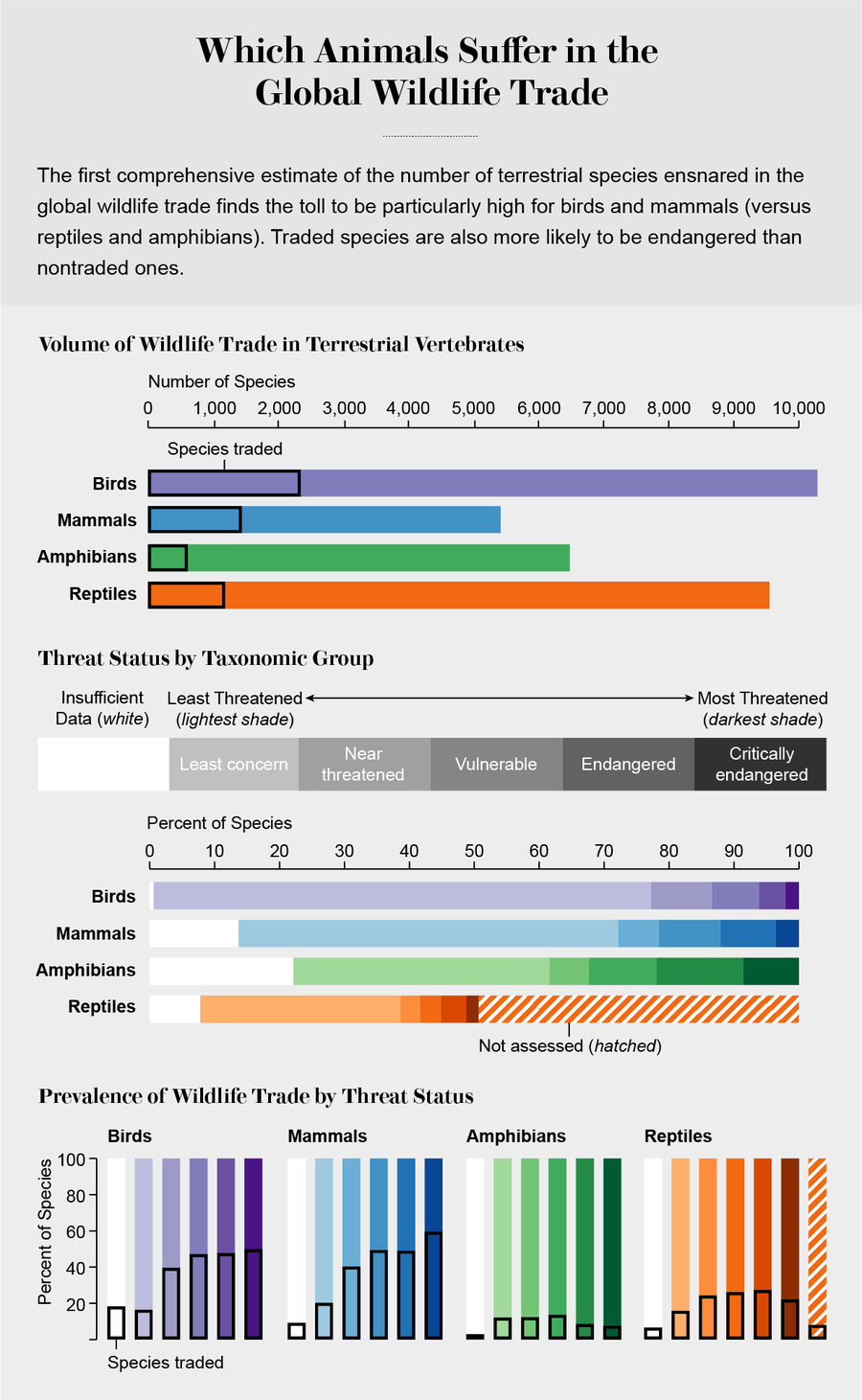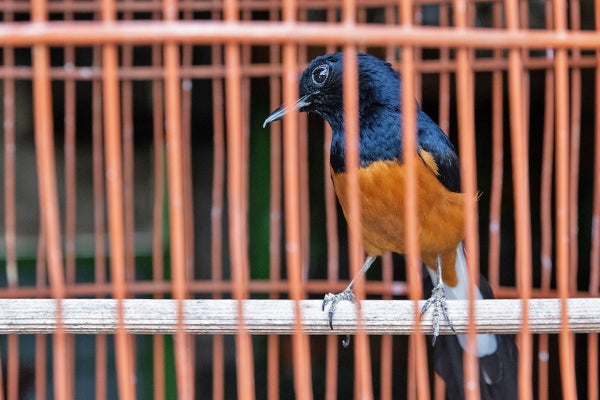The poaching of elephants, rhinoceroses and tigers regularly makes the news, but these well-known species comprise only a tiny fraction of the global wildlife trade—both legal and illegal. This is a multibillion-dollar industry that impacts animals ranging from softshell turtles and songbirds to rattlesnakes and otters. The exact count of affected species has always been a guess at best, however, because no single organization keeps track of these data.
Now researchers have produced the first such number, and it is colossal: nearly 5,600 species—about 18 percent of the planet’s known terrestrial vertebrate animals—are caught up in the trade. “Almost one in five is a very large number,” says Brett Scheffers, a conservation biologist at the University of Florida and lead author of the study, which was published Thursday in Science. “What’s surprising and important about this work is that, for the first time, we know the sheer magnitude of the global wildlife trade.” Scheffers’s team also predicts which species could be at risk next.
Several aspects of the modern world mean the wildlife trade has the ability to decimate affected species in a matter of just a few years. Globalization has accelerated and expanded trade in general, and affluence is increasing in many places where animals are traditionally in demand. Further, social media easily connect sellers with buyers at home and abroad. So when a species suddenly becomes a coveted commodity—whether it be something as common as a tokay gecko or as rare as an earless monitor lizard—things can suddenly spiral out of control. “In wildlife trade, there’s this market force that’s intensively focused on individual species,” Scheffers says. “A species that was safe 10 years ago can quickly transition to nearing extinction.”
On supporting science journalism
If you're enjoying this article, consider supporting our award-winning journalism by subscribing. By purchasing a subscription you are helping to ensure the future of impactful stories about the discoveries and ideas shaping our world today.

Credit: Amanda Montañez; Source: “Global Wildlife Trade across the Tree of Life,” by Brett R. Scheffers et al., in Science, Vol. 366; October 4, 2019
Both illegal and legal trade can trigger such a transition. Ensuring that the legal kind does not become unsustainable requires knowing which species are being traded—and where. The only major organizations that even partially keep track of such data are the International Union for Conservation of Nature (IUCN)—which assesses threat levels for various species and compiles scientists’ notes about whether those species are harvested for human use—and the Convention on International Trade in Endangered Species of Wild Fauna and Flora (CITES). CITES deals only with a small percentage of the wildlife traded around the world, however, and plants and animals are usually added to its list of protected species only after trade pushes them into crisis mode. “It’s a reactive approach, not a proactive one,” Scheffers says.
To fill this gap, Scheffers and his colleagues created a search algorithm that mined the IUCN’s and CITES’s databases for trade records of land animals. They found such information for 5,579 species, most native to tropical areas. Traded species were significantly more likely to be endangered than nontraded ones.
“I’m a little shocked by how large the trade is,” says Bill Laurance, a conservation biologist at James Cook University in Australia, who was not involved in the new paper. “I knew it was bad but not this bad, in terms of the proportion of species affected. This study is striking for this reason alone.”
Mapping the species’ evolutionary relationships, or phylogenies, further revealed that if one is highly traded, its close relatives are likely to be traded as well. “The way trade was plotted on the tree of life was very organized,” Scheffers says.
Based on this finding, he and his colleagues extrapolated the number of species that may eventually be impacted by trade because of their evolutionary closeness to those already being traded. They found an additional 3,196 species at risk of entering the market. This predictive approach “gives us an important idea of the types of species and ecosystems that will be most vulnerable to future wildlife trade,” Laurance says.
The predictions also track with the way wildlife trade is known to play out. As tigers have become rarer, for example, lion and jaguar parts have begun entering China’s black market as proxies. Likewise, while Asia depleted its populations of pangolins, or scaly anteaters—the world’s most trafficked mammals—traders quickly began sourcing African pangolin species and sending them to Asia.
Scheffers and his colleagues hope to expand their study to include orchids, trees, marine animals, freshwater fish and other species excluded from their algorithm because data were not as readily available (their study also did not include some crocodiles, lizards and alligators). “If you extend this to all the plants and fishes of the world, we’re talking many more thousands of species being traded as pets or products,” Scheffers says.
The researchers would like to map trade trends over time as well, he adds, because doing so would make the findings even more useful for policy makers and law-enforcement agencies. But Sue Lieberman, vice president of international policy at the Wildlife Conservation Society, raises doubts as to whether findings of this sort will result in any positive change on the ground. “A government manager might look at those interesting, colorful charts in the paper and conclude that we really need to be paying more attention to amphibian trade,” for example, she says. “Well, I think they know that already. Whether they do anything about it is another issue.”
